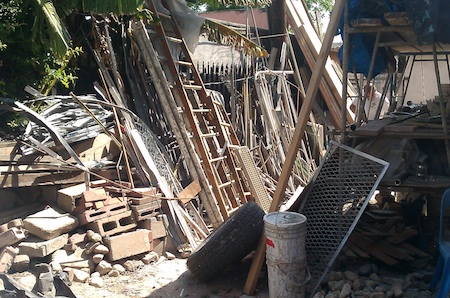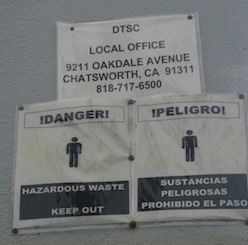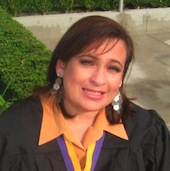By Martha Sánchez
Throughout the decades, South Los Angeles has been a victim of racialized spaces and racialized practices in a postindustrial economy, subjected to five aspects of dominance – infrastructure, industry, immigration, institutions and identity policies, as powerful regulatory tools were utilized by local government to carry out redevelopment plans and discriminatory ordinances.
But through it all, South LA residents have struggled to combat crime, corruption, infrastructural disinvestment, environmental contamination, racial and ethnic tensions, inadequate education, poverty and racial discrimination through grass roots organizing efforts.

Garbage on the property of a slumlord building that housed 40 tenants on W. 49th St. In January of this year, the Housing Department declared the building illegal and unfit for people to live in. (Photo: Javier Cortez)
Though once known as a semi-industrialized community with good jobs, the South Central community in Los Angeles continues entrapped in an era of economic decline, self-destruction, stigmatization and shame. The number of dilapidated buildings, poor infrastructure, substandard housing and environmental damage has forced residents to shout out “Ya basta!” (It’s enough!). People are tired of living in places where “nobody cares” and where racial discrimination is damaging people’s dignity and self-esteem. As a result, most black working and middle class former residents come across the “ghetto boundaries” searching for better opportunities and leaving behind nice Victorian and Craftsman style housing for Latinos.
The place where I live now dates back to the 1800’s. My home is located few blocks away from the historic jazz corridor. I moved to South LA at the end of 1999, seven years after the Rodney King beating. I can speak about the riots as an “outsider,” someone who witnessed the revanchist explosion of oppressed citizens in South LA from my home in Mexico.
At that time, we were constantly bombarded with the idea that “the riots began with the beating of Rodney King.” However, what happened in Los Angeles was the consequence of economic decline, cultural decay and political lethargy in American life, with race being the visible catalyst, not the underlying cause.
Contrary to popular thinking, the historical black community was changing even before the civil unrest. Most immigrants from Mexico and Central America started occupying the places that African-Americans left behind back in the 1960’s, after the community underwent a severe deindustrialization.
During that time, Gilbert W. Lindsay, a former City Hall janitor, became the first black Councilmember. Although Lindsay accomplished many structural changes that improved L.A.’s economy, he almost destroyed the southeast region of his council district by rezoning the historically black district from single-family homes into commercial and industrial zones.
Hundreds of beautiful Victorian and Craftsman homes were demolished to allow the construction of warehouses, commercial and industrial facilities.
Housing ordinances from 1964 helped blacks obtain better housing in suburbs like View Park, Baldwin Hills, San Bernardino and Riverside counties. I would dare to call that housing ordinance the once-in-a life time opportunity for the wealthy and middle class black community, since in most cases, it was handled as an “enclosed land transaction” between home owners and corporate land developers. Consequently, the next generation of Latinos who occupied the historical black neighborhood did so as a result from the economic restructuring and reindustrialization.
Under Lindsay’s administration, powerful city officials, regulators, landowners and profit-driven developers, changed all aspects of community planning. During his term, numerous wrecking yards and industrial facilities were located nearby existing schools, churches, and family homes. Those zoning decisions created even more problems because many of those industrial activities produced toxic fumes threatening the public health of the adjacent community members.

Signs outside the Palace Plating chrome plating facility shut down in December of 2011.
The lack of environmental standards allowed companies to release tons of toxic fumes into the environment through the air, soil and water, at the discretion of the owner. Though it is true that the distress confronted by the Latino community against industrial restructuring, poverty, environmental pollution and degradation is similar to other minorities, it is also well documented that Latinos, compared to African Americans, received less media attention. Ironically, the disproportionate impact of past policies still exists.
Places matter more to very poor people than to those who are better off. That’s evident when you hear people shouting in mass demonstrations “Aquí estamos y no nos vamos” (We’re here and we’re not leaving). There are hundreds of stories to write about survivors, unsung local heroes and unknown community activists.
We need space to signify dozens of testimonies from people involved in defeating a city policy that could allow the construction of a trash-to-energy incineration plant, the same lot that was called the Oasis in a Concrete Desert rented by the South Central Farmers. There are hundreds of public statements, community actions and successful stories surrounding economic development, jobs, affordable housing, rail-of-way connectors, public transportation, school sites, healthy food, liquor stores, and education opportunities before and after the civil unrest.
The South LA community should be better called “the home of the underdogs” always contending, defending, creating or supporting new ideas, policy changes, and economic opportunities.
 Martha Sánchez is a community activist and advocate, whose efforts led to the closure of Palace Plating, a toxic polluting plant just feet away from 28th Street Elementary.
Martha Sánchez is a community activist and advocate, whose efforts led to the closure of Palace Plating, a toxic polluting plant just feet away from 28th Street Elementary.















Speak Your Mind